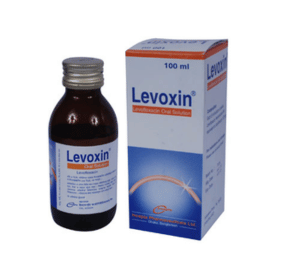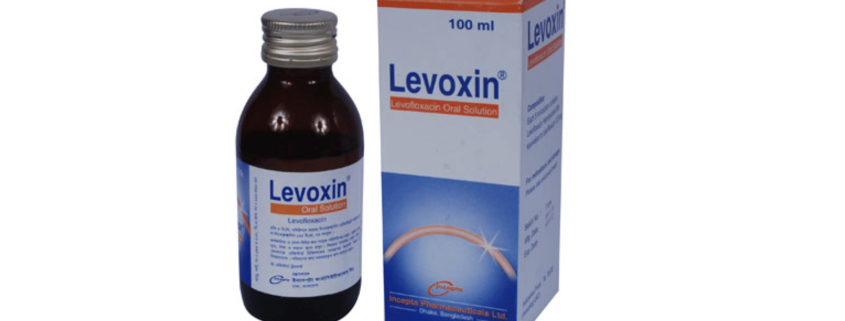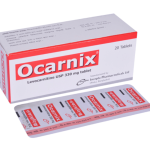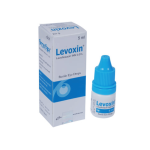Levoxin(Levofloxacin)

Therapeutic Group: Anti Bacterial
Presentation
Levoxin 250: Each film coated tablet contains Levofloxacin Hemihydrate INN equivalent to Levofloxacin 250 mg.
Levoxin 500: Each film coated tablet contains Levofloxacin Hemihydrate INN equivalent to Levofloxacin 500 mg.
Levoxin 750: Each film coated tablet contains Levofloxacin Hemihydrate INN equivalent to Levofloxacin 750 mg.
Levoxin 100 ml oral solution: Each 5 ml solution contains Levofloxacin Hemihydrate INN equivalent to Levofloxacin 125 mg.
Levoxin IV Infusion: Each 100 ml solution contains Levofloxacin Hemihydrate INN equivalent to Levofloxacin 500 mg.
Description
Levofloxacin is a synthetic, broad-spectrum, third generation fluoroquinolone derivative antibacterial agent. Chemically levofloxacin is a chiral fluorinated carboxyquinolone.
Indications
Levofloxacin is indicated for the treatment of mild, moderate, and severe infections caused by susceptible strains of the designated micro-organisms in the condition listed below:
– Acute maxillary sinusitis due to Streptococcus pneumoniae, Haemophilus influenzae, or Moraxella catarrhalis
– Acute bacterial exacerbation of chronic bronchitis due to Staphylococcus aureus, Streptococcus pneumoniae
– Haemophilus influenzae, or Moraxella catarrhalis
– Community-acquired pneumonia due to Staphylococcus aureus, Streptococcus pneumoniae, Haemophilus
– influenzae, Klebsiella pneumoniae, Moraxella catarrhalis, Chlamydia pneumoniae, Legionella pneumophila, or Mycoplasma pneumoniae
– Uncomplicated & complicated urinary tract infections due to Escherichia coli, Klebsiella pneumoniae, or Staphylococcus saprophyticus
– Acute pyelonephritis caused by Escherichia coli
– Uncomplicated & complicated skin and soft tissue infections including abscesses, cellulitis, furuncles, impetigo, pyoderma, wound infections, due to Staphylococcus aureus, Streptococcus pyogenes, Proteus mirabilis or Enterococcus faecalis
– Enteric infections caused by Enterobacter sp., Escherichia coli, Campylobacter sp., Vibrio cholerae, Shigella sp., Salmonella sp.
Dosage & Administration
Levoxin Tablet:
The usual dose of Levoxin Tablets is 250 mg or 500 mg or 750 mg administered orally every 24 hours. Levoxin tablets can be administered without regard to food. Levofloxacin oral solution should be taken 1 hour before, or 2 hours after eating.
Levoxin Injection:
Levoxin injection should only be administered by intravenous infusion. It is not for intramuscular, intrathecal, intraperitoneal, or subcutaneous administration. The usual dose of Levoxin injection is 250 mg or 500 mg administered by slow infusion over 60 minutes every 24 hours or 750 mg administered by slow infusion over 90 minutes every 24 hours. Since the Levoxin injections are for single-use only, any unused portion should be discarded. Additives or other medications should not be added to Levoxin Injection or infused simultaneously through the same intravenous line.
Adult
– Acute sinusitis: 500 mg once daily for 10-14 days, or 750 mg once daily for 5 days
– Exacerbation of chronic bronchitis: 500 mg once daily for 7 days, or 750 mg once daily for 3 days (Uncomplicated), 750 mg once daily for 5 days (Complicated)
– Community-acquired pneumonia: 500 mg once daily for 7-14 days, or 750 mg once daily for 5 days
– Uncomplicated urinary-tract infections: 250 mg once daily for 3 days
– Complicated urinary-tract infections and acute pyelonephritis: 250 mg once daily for 7-10 days
– Uncomplicated skin and soft-tissue infections: 500 mg once daily for 7- 10 days
– Complicated skin and soft-tissue infections: 750 mg once daily for 7-14 days
– Enteric fever: 500 mg once daily for 7-14 days
– Diarrhea, cholera, shigellosis & enteritis:
– – Mild to moderate case: 500 mg (single dose)
– – Moderate to sever case: 500 mg once daily for 3 days
Children
– Children 6 months to <5 years: 10 mg/kg every 12 hours
– Children > 5 years:10 mg/kg every 24 hours
In each case, sequential therapy (intravenous to oral) may be instituted at the discretion of the physician.
Side Effects
Levofloxacin is generally well tolerated. However, a few side-effects can usually be seen. Side-effects include: nausea, vomiting, diarrhea, abdominal pain, flatulence and rare occurrence of phototoxicity ( 0.1%). Side-effects that may be seen very rarely include tremors, depression, anxiety, confusion etc.
Precautions
The following measures should be taken during administration of Levofloxacin:
– Levofloxacin Injection should only be administered by slow intravenous infusion over a period of 60 or 90 minutes depending on the dosage.
– While administrating Levofloxacin, adequate amount of water should be taken to avoid concentrated form of urine.
– Dose adjustment should be exercised during Levofloxacin administration in presence of renal insufficiency.
Levoxin eye drops should not be injected subconjunctially, nor should it be introduced directly into the anterior chamber of the eye. Avoid contaminating the applicator tip with material from the eye, fingers or other source.
Use in Pregnancy & Lactation
Levofloxacin is not recommended for use during pregnancy or nursing, as the effects on the unborn child or nursing infant are unknown.
Drug Interaction
No quinolone should be co-administered with any solution containing multivalent cations, e.g., magnesium, through the same intravenous line. Antacids, Iron and Adsorbents reduce absorption of Levofloxacin. NSAID may increase the risk of CNS stimulation. Warfarin may increase the risk of bleeding.
Over Dose
Levofloxacin exhibits a low potential for acute toxicity. However, in the events of an acute overdosage, the stomach should be emptied. The patients should be kept under observation and appropriate hydration should be maintained.
Commercial Pack
Levoxin 250 : Each box contains 3 blister strips of 10 tablets.
Levoxin 500 : Each box contains 3 blister strips of 10 tablets.
Levoxin 750 : Each box contains 1 blister strip of 10 tablets.
Levoxin 100 ml oral solution: Each bottle contains 100 ml oral solution.
Levoxin IV Infusion: Each box contains 1 bag of 100 ml solution for injection.
Others
Instructions for the Use of Levoxin Infusion:
1. Check the container for minute leaks by squeezing the inner bag firmly. If leaks are found, or if the seal is not intact, discard the solution.
2. Do not use if the solution is cloudy or a precipitate is present.
3. Do not use flexible containers in series connections.
4. Close flow control clamp of administration set.
5. Remove cover from port at bottom of container.
6. Insert piercing pin of administration set into port with a twisting motion until the pin is firmly seated.
7. Suspend container from hanger.
8. Squeeze and release drip chamber to establish proper fluid level in chamber during infusion of Levoxin Injection.
9. Open flow control clamp to expel air from set. Close clamp.
10. Regulate rate of administration with flow control clamp.



